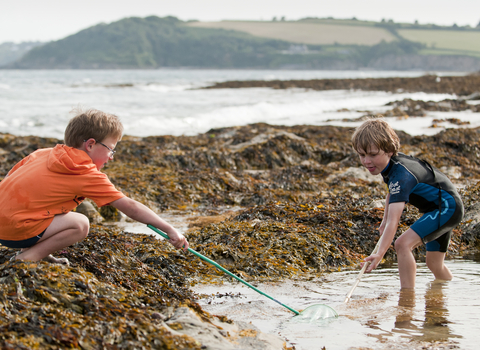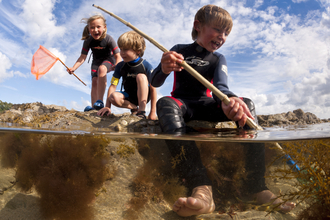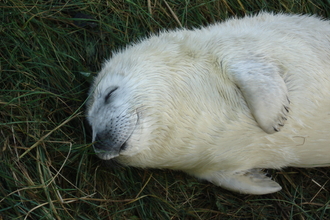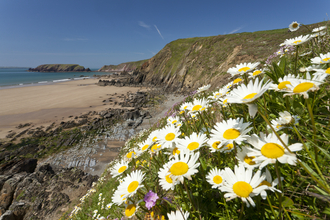Rock pooling
Whether it is a skulking crab, a delicate star fish or the tentacle blooms of a sea anemone, there is always something to find just below the surface: There is a microcosm of vibrant life that is played out between the tides. One way to discover more about the wildlife that exists along our coast is to spend time rockpooling – whether young or old, exploring beaches and bays can be a truly magical experience.
When the waves have retreated, a whole world emerges at the shoreline
Find rockpools
Here is a selection of some of the best places to explore rock pools around the UK's coast. Although not all Wildlife Trust nature reserves, don't hesitate to contact the regional Trust for more information.
North
Cumbria Wildlife Trust
St Bees Beach - England’s only breeding colony of black guillemots resides at the northern end of St Bees Beach. Beneath the cliffs are a number of rock pools where it's easy to find shore crabs, anemones, whelks and periwinkles. The southern point has large honeycomb worm reefs. Each year Cumbria Wildlife Trust hold a ‘Beached Art’ event here with a sand sculpture competition, rock pooling, coastal walks and bird watching.
Where is it? 5 miles south-west of Whitehaven. The beach is very long and there is northern and southern access points. Both areas have car parks.
Allonby Bay runs alongside the Maryport Golf Club in Cumbria and has an interesting reef of boulders. Competition for space on the rocks is fierce. Unusually, the entire wildlife community here switches between two alternate states – mussel beds and reefs of honeycomb worms - each with its own array of plants and animals. Cumbria Wildlife Trust hold regular beach walks here.
Where is it? The town of Maryport is only a 20 minute drive from Cockermouth. Head along the coastal road north of the town centre to the bay just 5 minutes away.
Durham Wildlife Trust
Seaham Beach is on the Durham Heritage Coast, south of Sunderland and east of Durham. There is a lovely beach and rock pools where the Durham Wildlife Trust often run events in the summer. Species that were found last year include common starfish, velvet swimming crab, hermit crab and butterfish (or rock gunnel). There is car parking at the Seaham Hall beach car park.
Where is it? 15 minutes drive (approx. 6 miles) along the A1018 coming south from Sunderland.
Northumberland
Cresswell Foreshore - Five species of crab have been recorded here, including the porcelain crab, and both butterfish and shanny have also been seen. There is a good variety of seaweeds, including kelp and the pink, feathery coral weed. The site extends up to the sand dunes and is visited by a wide variety of wading birds, including turnstone, purple sandpiper, sanderling and ringed plover. The Trust holds rock pooling events here every Marine Week in August.
Where is it? Cresswell village is 4 miles north of Ashington, the beach is 1 mile walk north of the village centre.
Tees Valley Wildlife Trust
Saltburn by the Sea - The beach at Saltburn by the Sea in Cleveland is close to the Tees Valley Wildlife Trust nature reserve at Saltburn Gill. There’s everything you need here for a day at the seaside, a long pier, eight miles of golden sands, rock pools, huge cliffs and a promenade full of shops and cafes. At low tide the rock pools are accessible, and a variety of species can be found including crabs, squat lobsters and starfish which live alongside beautifully coloured sea anemones, sponges and sea slugs.
Where is it? On the east coast 12 miles east of Middlesbrough and 25 miles west of Whitby. Saltburn also has a railway station. Saltburn Gill.
Yorkshire Wildlife Trust
Flamborough Headland - Stroll from the Yorkshire Wildlife Trust's Living Seas Centre to the beach at South Landing on Flamborough Headland. The white chalk boulders create a rockpooling paradise for all manner of marine creatures and on a low tide a fantastic kelp forest is exposed. Crab and lobster are plentiful here along with anemones, periwinkles and piddocks. Trust officers based at the Living Seas Centre run Seashore Safaris for all ages and Shoresearch for those who may want to develop their rocky shore wildlife identification skills. Activities run all year round, depending on the weather conditions.
Where is it? Take the B1255 north from Bridlington to Flamborough. Head down South Sea road from Flamborough to South Landing.
South
Cornwall Wildlife Trust
Polzeath Beach - A wealth of invertebrate life clings to the rocks and hides amongst the crevices at Polzeath beach. The beach is part of a Voluntary Marine Conservation Area and the importance of this area for its marine wildlife has been recognised, so people are encouraged to rock pool sensibly and thoughtfully by following the seashore code. Cornwall Wildlife Trust carries out regular rock pool wildlife surveys here and easy access rockpool rambles.
Where is it? On the North Coast of Cornwall, 6 miles north of Wadebridge.
Hannafore Point in Looe is a sheltered area of rocky shore and is central to the Looe Voluntary Marine Conservation Area (VMCA). It’s covered in seaweeds of all shapes and sizes, which in turn provide shelter and food for a web of seashore life including starfish, crabs, shore fish and anemones. If the tide is low you may even be lucky enough to find the huge mermaids purse (empty egg cases of the nursehound shark) attached to the weed, or the occasional scallop sitting on the sandy bottom between rocky gullies. Keep an eye out for Cornwall Wildlife Trust rockpooling events!
Where is it: Hannafore Point is in West Looe, over the harbour bridge and down to the most southern point (takes 10 minutes).
Gyllyngvase Beach - Cornwall Wildlife Trust holds regular marine discovery days at Gyllyngvase Beach near Falmouth. The many rock pools here are bursting with colourful life. In the shallow pools on the upper shore you’ll find winkles and shrimps, while the deeper pools on the reef edge are full of squat lobsters and crabs. This accessible site is a great place to enthuse young rock poolers.
Where is it? Gyllyngvase Beach lies just below the coast road and promenade on Falmouth's waterfront.
St. Agnes Beach - The large village of St. Agnes on the north Cornish coast is a rock pool heaven. In common with other north Cornish sites, this is a sandy beach with boulders and rocky outcrops. You'll find lots of different seaweeds, as well as topshells, winkles, limpets, dahlia anemones, cushion stars and crabs. It's a good spot for fish too, including Cornish sucker fish, blennies, rocklings and sea scorpions. Explore the overhangs and gullies for star seasquirts and a variety of sponges.
Where is it? Travelling south-west from Newquay, St Agnes is 10 miles - approximately 25 minutes by car.
Devon Wildlife Trust
Wembury Beach - Devon Wildlife Trust runs regular rock pool rambles on the beach at Wembury, in south Devon. Wembury is a wildlife hotspot and Voluntary Marine Conservation Area. Its rocky cliffs are home to nesting sea birds, while a rocky shore, slate reefs and massive wave-cut rock platforms provide one of the UK's best spots for marine plants and animals. Wembury Marine Centre is the ideal place to learn about the surrounding area and its wildlife through interactive displays, aquaria and regular rock pool rambles and family events.
Where is it? Wembury is 7 miles south-east of Plymouth. For the beach and Marine Centre continue through the village of Wembury following signs for Beach. National Trust car park (charge for non-NT members.)
Dorset Wildlife Trust
Kimmeridge Bay - The Dorset Wildlife Trust’s Fine Foundation Marine Centre is open throughout the summer at Kimmeridge Bay with interactive displays, aquaria and rock pool rambles. Other things to do here include mini-beast hunting, seabird spotting, fossil rubbing and eco-crabbing, with all equipment provided. You can also hire Seashore Explorer backpacks containing a rock pool-friendly crab line, seashore ID guides and magnifying pots. The included crab kit and fossil rubbing kit are to keep.
Where is it? Take the A351 from Wareham to Corfe Castle. Turn right at signage to Creech and right again at signage to Kimmeridge.]
Hampshire and Isle of Wight Wildlife Trust
Bembridge Ledges - The shallow ledges at Bembridge are a wonderful place to take youngsters rock pooling. Look out for beadlet anemones and tiny brittlestars. Bembridge has been recommended as a Marine Conservation Zone as many rare species are found here including seahorses, stalked jellyfish and peacock’s tail seaweed. Hampshire and Isle of Wight Wildlife Trust runs regular 'rockpool rummages' here.
Where is it? 7 miles from Ryde on the Isle of Wight. There is a car park at the end of Lane End Road (PO35 5TD) next to the RNLI shop.
Somerset Wildlife Trust
Porlock Weir - The village of Porlock Weir is right on the shingle beach, and with village amenities close to hand it makes an ideal spot for a family beach safari. The Old Red Sandstone boulders that form the beach here have created a multi pool habitat that is great to explore at low tide. Marine molluscs, sea anemones, crabs and a wide range of other marine invertebrates and a great variety of seaweeds are all potential finds for the eagle-eyed seashore scout.
As well as the common beadlet anemone you will find snakelocks anemone, strawberry anemone, dog whelk, common brittle stars and the exotic looking common sun sea star. This site is now being used by the Somerset Wildlife Trust as a regular intertidal marine life survey point.
Where is it? Porlock is 5 miles west of Minehead. The weir is 1.5 miles west of the centre. There is a car park by the shore.
Sussex Wildlife Trust
Seven Sisters - The beach at Seven Sisters is used for schools and educational group visits run by Sussex Wildlife Trust as well as holiday events, which include rock pooling days. These rock pools are a great place to find all the usual suspects that inhabit the Sussex shoreline - some of the most frequently seen inhabitants include the green shore crab, the beadlet anemone and the common periwinkle.
The beach is also a site which is included in the Sussex Shoresearch programme, surveying shoreline wildlife - so detailed records are held of the organisms which have been found here. Rock pooling events are held over the summer.
Where is it? Seaford is half an hour’s drive east of Brighton and there is a carpark only a mile’s walk from the beach.
East
Norfolk Wildlife Trust
West Runton Beach - Norfolk Wildlife Trust runs rock pool rummaging events on West Runton beach throughout the summer and shore crabs, beadlet anemones, starfish and squat lobsters are some of the commonly encountered species here. Children who take part in rock pooling can also get involved in fossil finding, and these sessions not only help children to understand the natural world around them, but also how their actions affect wildlife and habitats. The Trust tailor’s sessions to suit the needs of any age group.
Where is it? The beach is 5 miles west of the town of Cromer. The X5 bus travels from Norwich, through Cromer to West Runton.
Wales
North Wales Wildlife Trust
Porth y Pwll - Along this stretch of coastline are many fantastic rock pooling bays. Porth y Pwll is just one of those, providing pools, gullies and boulders for exploration on an ebbing tide. On spring tides rummage in the kelp beds or take a torch and look into crags under large boulders or in bedrock crevices. Large seaweedy pools hide a variety of creatures, and don't forget to marvel at the variety of seaweeds themselves! Species highlights include blue rayed limpets, lobsters, squat lobsters, cushion stars, sunstars and sea hares.
Where is it? Head east from the village of Trearddur Bay, along Lon Isallt road towards Holyhead.
Cemlyn Bay - There’s some great rock pooling to be had at Cemlyn Bay at North Wales Wildlife Trust's Cemyln nature reserve. Here you’ll find a range of different types of shore within walking distance of each other. Take some time to lift your head up from the rock pools and you’ll see terns flying close overhead with beaks full of fish. If you visit nearby Trwyn Cemlyn it’s always worth keeping an eye out for seals, porpoises and dolphins. Never a dull rockpool ramble here!
Where is it? 45 minutes from Bangor and on the coast of Anglesey.
The Wildlife Trust for South and West Wales
Cold Knap Point - Crabs, shrimps, small fish, limpets, a rainbow of periwinkles can be found whilst rock pooling at Cold Knap Point. This gently sloping pebble beach has lots of crinoids and ‘cockles’ in its rocks, and the cliffs are so low that a rising tide is no threat. Cold Knap beach to the west is good place to find other fossils in the limestone such as gryphea (commonly known as devil’s toenail) and ammonites.
Where is it? Take the A0455 (Cardiff Road) from Cardiff to get to Barry. Cold Knapp Point is a twenty minute walk from centre on the west coast of Barry.
Scotland
Scottish Wildlife Trust
Crail Roome Bay - A south-facing sandy cove in the beautiful fishing village of Crail with plenty of great rock pools to explore. Only 10 minutes walk from the centre of Crail, the beach offers peace and quiet and a brilliant place to see a variety of sea creatures. There is a sloping grassy area and children’s playground nearby, and a small, old disused swimming pool is now a haven for local wildlife. The Scottish Wildlife Trust’s nearby Fife Ness Muir and Kilminning Coast nature reserves attract migrant birds, and in 2013 the bay won Fife's 2013 Seaside Award.
Where is it? The bay is a 10 minute walk from Crail centre.
Killiedraught Bay, within the Scottish Wildlife Trusts 'St Abbs and Eyemouth Voluntary Marine Reserve', is one of the finest rock pooling sites in Scotland. At low tide you’ll find seaweeds such as bladderwrack and kelp, as well as animals such as the breadcrumb sponge, bootlace worm and butterfish. The cliffs at St Abbs Head, a short way up the coast, are home to 50,000 seabirds in spring and summer, including guillemots, razorbills, kittwakes and shags.
Where is it? It's a 20 minute drive north of Berwick-upon-Tweed to get to Eyemouth. The bay is a 15 minute walk from the centre.
Calgary Beach, Isle of Mull - At Calgary beach not only can you find urchins, starfish, crabs, squat lobsters and jellyfish, but if you’re very lucky you might spot otters playing on the shore. Seals, porpoises, dolphins and minke whales are also regular visitors around the island’s coast.
Where is it? Calgary beach is on the north-west coast of the Island of Mull, 12 miles from the Islands capital, Tobermory.
Northern Ireland
Ulster Wildlife Trust
Dunseverick Harbour - Dunseverick Harbour (near Portrush, Co Antrim) has the deepest natural pools in Northern Ireland. Here you can swim amongst an extraordinary range of marine plants and animals, including the sea hare, china limpet and needle whelk. You can learn more about the history of the Dunsvernick area on the 'Causeway Coastal Walk'. Rathlin Island nearby is home to sponges that are found nowhere else in the world.
Where is it? On the North Coast of County Antrim, Northern Ireland. The village of Dunserverick is a 15 minute drive west of Ballycastle.
Islands
Alderney Wildlife Trust
Longis Bay - The inviting sandy expanse of Longis Bay is set between the Nunnery and Victorian Fort Raz on Alderney Island. One of the most popular beaches here, Longis Bay never seems to get crowded and offers safe bathing and a great variety of environments to explore. Alderney Trust run events throughout the summer including kayaking and rock pool snorkelling (equipment provided). Where is it? On the South East coast of the island. Accessed by main road E from St Annes
Clonque - Ramsar Site
Isles of Scilly
Anywhere around the coasts on the Islands is fantastic for rockpooling.
What to look for
Plants and animals that live in rock pools are both fascinating and hardy, surviving a constantly changing environment; fluctuating water temperatures, decreasing oxygen levels, and exposure to sunlight for long periods of time, as well as rough treatment from the incoming sea. Look out for shrimp in the pools, crabs skulking under clumps of seaweed, while starfish cling to the rocks that anchor seaweed. Molluscs, barnacles and anemones sit on the pool floor, and you might see larger creatures like lobster if you’re lucky!
Remember to follow the seashore code and handle all wildlife with care. Only keep one animal in a bucket at any one time and make sure to put everything back where you found it.
If you can't get to these places
If you can’t get to one of these special sites there is always something amazing to find around the UK's coastline. Try walking along the strand line to see what the high tide has left behind - whether it is seaweed, shells or the distinctive internal shell of the cuttlefish.
More wildlife experiences
From seeing colourful wildflowers to spotting magnificent birds of prey, we can help you get closer to wildlife across the UK.








